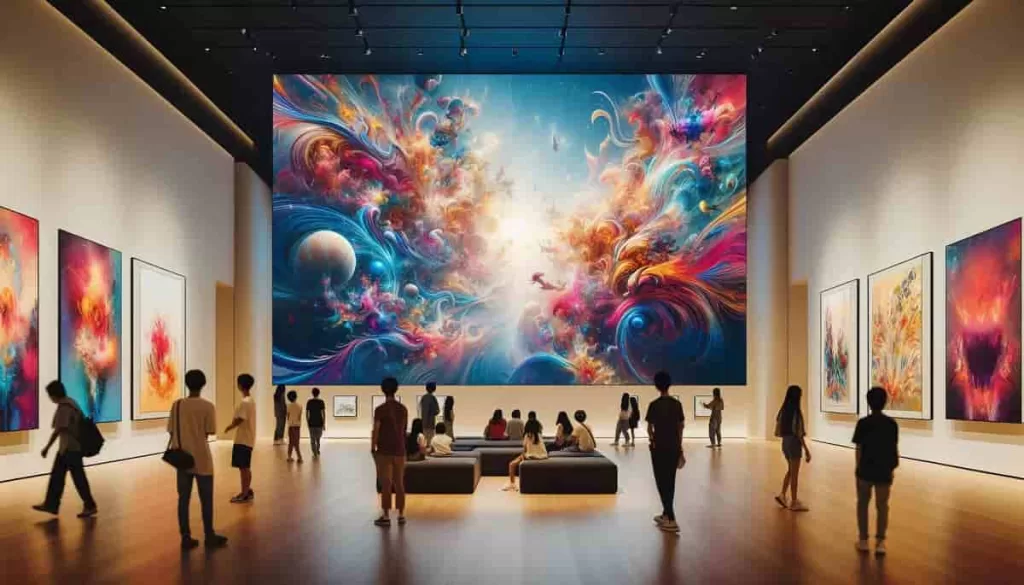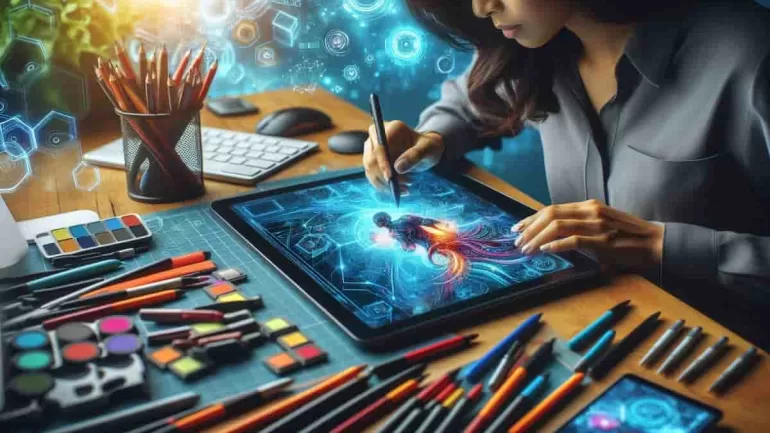DIGITAL ART
A digital artist working on a futuristic tablet creating a vibrant and detailed digital painting. But the question remains: Are digital artists real artists?
Are digital artists real artists? Explore the evolving perception of digital art and its place in museums, galleries, and the broader creative community.
BY KAZEEM ADELEKE, ARTCENTRON
In recent years, the debate over whether digital artists can be considered “real artists” has intensified, especially as digital art has gained significant popularity and recognition in both the art world and pop culture. But are digital artists “real artists,” or does their reliance on technology disqualify them from being in the same category as traditional artists? To find an answer to this pertinent question we will explore it in-depth, looking at the historical context of art, the nature of digital art, and the changing perceptions of what it means to be an artist.
The Definition of Art: A Broad and Evolving Concept
Art is a form of human expression, creativity, and imagination, communicated through a variety of mediums. The traditional definition of art has long been rooted in physical forms, such as paintings, sculptures, and drawings. These physical mediums have shaped how society has historically recognized “real” artists. But as technology continues to evolve, so does the concept of art itself.
Over the centuries, artists have pushed the boundaries of materials and techniques. The Renaissance brought us oil paints, the 20th century saw the rise of abstract art, and now, in the digital age, the digital canvas has emerged as a legitimate medium. With the rise of computers, tablets, and digital tools, many artists are now creating entirely new forms of art that blend creativity with technology.
What Is Digital Art?
Digital art refers to any artwork that is created with the help of digital technology. This can include works made using digital painting software like Adobe Photoshop or Procreate, 3D modeling software, or even generative art powered by artificial intelligence. Unlike traditional art forms that often require physical materials (paint, clay, canvas, etc.), digital art typically comes from using a screen, a stylus, a mouse, or other input device.
The digital medium is incredibly versatile, allowing artists to experiment with new styles, techniques, and workflows. It can also include animation, graphic design, video art, and interactive installations. Digital art extends beyond any one genre or category, and its diversity makes it a fascinating and dynamic part of the contemporary art landscape.
Historical Context: From Traditional to Digital
To understand why the debate about digital art being “real art” is even relevant, it’s helpful to look at how art has evolved over time. Historically, what we now call “traditional art” was once the cutting-edge innovation. When oil painting was first developed in the 15th century, it revolutionized the art world. Before that, artists used egg tempera, frescoes, or other primeval methods to create their works. The introduction of photography in the 19th century also raised similar questions, with many questioning whether photography could truly be considered art.
Art has always been a reflection of the tools and technologies available at the time. The very notion of what constitutes art has evolved alongside the tools that artists have used. So why should digital art be treated any differently? The question, “Are digital artists real artists?” echoes the same questions asked in the past: “Are photographers real artists?” or “Is abstract art really art?”
The Skills Behind Digital Art: Is It the Same as Traditional Art?
One of the core arguments against digital art as “real” art often centers around the belief that digital artists are not using the same skill set as traditional artists. Traditional art involves mastering materials like pencils, brushes, and clay, and it requires a deep understanding of light, color, texture, and form. Digital artists, on the other hand, work with software and digital tools that some argue might make the process easier.
However, this argument overlooks the fact that digital art, like traditional art, requires a high level of skill and technique. Digital artists must master software and understand design principles. Additionally, they have to develop an eye for composition, just as traditional artists must learn to handle their chosen medium effectively. In fact, digital tools often require unique skills in themselves. They include navigating complex interfaces, mastering layers, and blending techniques, or using 3D rendering software.
Additionally, digital art involves a creative process that parallels the journey of any traditional artist: conceptualizing an idea, refining it through drafts or studies, and executing a final piece. The difference lies in the tools and medium used, not the fundamental nature of the creative process.
The Role of Technology: Changing Perceptions
As technology continues to advance, the art world is also changing. Many modern artists are incorporating digital tools into their workflow, blending traditional methods with digital ones. For example, a traditional painter might use digital sketches to plan their composition or use photo-editing software to manipulate their work before printing it on canvas. These hybrid approaches reflect how digital tools are not replacing traditional art but enhancing and expanding it.
Moreover, digital art has made art more accessible than ever. With just a tablet and stylus, aspiring artists can create high-quality pieces and share them with a global audience. This accessibility has democratized art, allowing for new voices and perspectives to emerge in ways that traditional art forms may not have been able to support.
Digital Art in the Art Market
A key component of the debate about whether digital artists are real artists is the recognition and valuation of their work in the art market. Traditionally, physical artworks were the dominant form of investment, with buyers looking to acquire paintings, sculptures, and other tangible pieces. However, the rise of NFTs (Non-Fungible Tokens) has significantly impacted the art world. Digital artists are now able to sell their works as one-of-a-kind, authenticated assets through blockchain technology. This has led to millions of dollars in sales for digital art, proving that collectors, investors, and art enthusiasts value digital creations as highly as traditional art.
NFTs, in particular, have sparked new conversations about the definition of art and the role of digital technology in the art world. Some critics argue that the market for NFTs is a passing trend, while others see it as the future of art collecting. However, regardless of opinions on the NFT market, digital artists are increasingly gaining recognition for their contributions to the art world.
The Legitimacy of Digital Art in Galleries and Museums

Why Are Digital Artists Real Artists?
Another area where digital art has gained ground is in museums and galleries. More and more, digital art exhibitions are taking place at prestigious institutions. They include the Museum of Modern Art (MoMA) in New York, the Tate Modern in London, and the Centre Pompidou in Paris. These exhibitions showcase digital artists’ work alongside traditional forms. This signals a shift toward greater acceptance and recognition of digital art as a legitimate form of artistic expression.
The inclusion of digital art in established art spaces challenges the notion that digital art is not “real” art. In fact, it highlights that the boundaries of what is considered art are constantly shifting. As digital technologies continue to evolve, so too will how we appreciate and define art.
Arguments Against Digital Art as “Real” Art
While there is growing acceptance of digital art, there are still critics who argue that digital artists are not “real” artists. These critics often claim that digital tools make the creative process too easy or that digital art lacks the “soul” or “authenticity” of traditional media. Some critics also believe that digital art doesn’t have the same materiality or tactile quality as traditional art, making it less “real.”
However, these arguments often stem from a lack of understanding of the creative process involved in digital art. Just because a digital artist does not use physical materials does not mean they are not producing meaningful, authentic work. The emotional depth, technical skill, and creativity required to create digital art are no less significant than those needed for traditional art.
Tips for Aspiring Digital Artists
If you’re considering becoming a digital artist, here are some tips to guide you:
- Master the Tools: Familiarize yourself with popular software such as Adobe Photoshop, Illustrator, or Procreate. Learning the tools of the trade is crucial to developing your style and technique.
- Practice, Practice, Practice: Just like any form of art, digital art requires constant practice. Experiment with different styles, techniques, and software features to hone your skills.
- Study Traditional Art: Many successful digital artists have a background in traditional art. Learning the fundamentals of composition, color theory, and perspective will improve your digital art.
- Build a Portfolio: Create a strong portfolio to showcase your work. This can help you attract clients or gain recognition within the art community.
- Stay Inspired: Explore different genres of digital art, attend exhibitions, and collaborate with other artists. Keeping your creative spark alive is essential for success.
Final Thoughts: Are Digital Artists Real Artists?
In the end, the question of whether digital artists are “real” artists is a matter of perspective. As with any art form, the value of digital art lies in the creativity, technique, and emotional depth of the artist. Whether using a canvas and paintbrush or a tablet and stylus, artists express themselves through their chosen medium, and digital art is no exception.
As society and technology continue to evolve, the definition of “real” art will continue to shift. But one thing remains clear: digital artists, like their traditional counterparts, are pushing the boundaries of creativity and leaving their mark on the world of art.
By embracing the advancements of digital tools and technology, digital artists are carving out their place in the ever-evolving world of art. Whether or not people consider “real” artists, their contributions are undeniably shaping the future of art.
